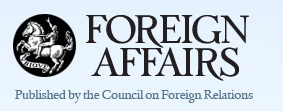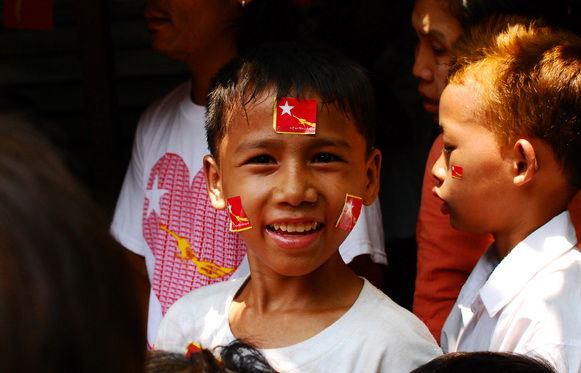
Geopolitics Trumps Democratic Reforms
Not too long ago it would have been unthinkable: the sight of a U.S. president standing next to Aung San Suu Kyi, the woman many believe should be — and might yet become — the president of her long-suffering country, Myanmar (also known as Burma). When Barack Obama was first elected to the White House in 2008, the world-famous champion of democracy was under house arrest, confined to her family’s crumbling lakeside villa in the country’s former capital, Rangoon. Today, as an elected member of parliament, she welcomed Obama to her porch on his first overseas trip since his re-election. Speaking to reporters, the president lauded her “unbreakable courage and determination” and vowed U.S. support for the reforms that, in little over 18 months, have transformed Myanmar.
During his six-hour stop, Obama also held talks with President Thein Sein, the former general who is credited with the recent opening, and spoke to students at the University of Yangon, close to where the British accepted the Japanese surrender in August 1945. Obama’s four-day tour of Southeast Asia epitomizes his administration’s much-vaunted “pivot” toward the region, and includes visits to Thailand and Cambodia, where he will attend the East Asia Summit tomorrow; the Myanmar stop, however, provides the most dramatic example of this rebalancing. The visit marks the first time that a sitting U.S. president has visited the country and epitomizes the country’s breakneck transition from international pariah state — once muttered in the same breath as North Korea and Iran — to something of a democracy in waiting.
Since Thein Sein took office at the head of a nominally civilian government in March 2011, the government has released hundreds of political prisoners, relaxed restrictions on the press, and welcomed Aung San Suu Kyi back into the political mainstream. In lower Myanmar, especially Rangoon, residents have reveled in the more open atmosphere. Images of Aung San Suu Kyi, once banned, are plastered like religious icons on walls and T-shirts, and the red peacock flag of her National League for Democracy (NLD) flies from balconies and antennas. The government has also begun to reform the country’s moribund economy, removing the country’s old two-tiered foreign exchange system and passing a new foreign investment law.

NLD supporters rally in advance on Myanmar’s April 1 by-election (Sebastian Strangio)
The Western response has been gushingly enthusiastic. The United States, along with the European Union, Australia, Japan, and other Western democracies, has rapidly eased restrictions on firms wishing to do business in the country and moved to dismantle the sanctions that have been in place since the early 1990s. Foreign firms, including Coca-Cola, Suzuki, and Visa, are lining up to cash in on the untapped market of 50 million people. In August, the World Bank set up shop in Rangoon after a 25-year absence, and it has authorized a new aid package worth $245 million. Kristian Berg Harpviken, the head of the Peace Research Institute Oslo, even went so far as to place Thein Sein on his shortlist of five nominees for the 2012 Nobel Peace Prize, for his efforts in “spearheading a gradually evolving peace process.”
The speed of the U.S.-Myanmar thaw can be explained in part by the sudden dovetailing of the two countries’ geopolitical interests. For Myanmar, China was a source of diplomatic and economic support during years of isolation. During that time, Chinese investment flooded into the north of the country. In Mandalay, Myanmar’s second-largest city, Chinese nationals now make up around a third of the population, a fact that has stoked fears among many people in the country. As the Myanmar expert Bertil Lintner has argued, the generals perceived this overreliance on Beijing as a “national emergency” that threatened Myanmar’s independence. Many of the recent reforms, including Aung San Suu Kyi’s release, were thus pursued with the goal of winning new foreign friends to counterbalance China’s influence.
This pivot matches Obama’s own much-vaunted shift toward Asia. Under the Clinton and George W. Bush administrations, U.S. policy toward Myanmar was governed essentially — and somewhat anomalously — by moral imperatives. Leaders of Myanmar were blacklisted from entering the country, which Bush described as an “outpost of tyranny,” and harsh sanctions were instituted. But the policy arguably yielded little other than to push the junta into China’s camp and to deepen its isolation.
After years of ineffectual sanctions, however, there’s a strong argument that Obama’s visit is an overcompensation. Brad Adams, the Asia director at Human Rights Watch, has said that the presidential trip “risks providing an undeserved seal of approval to the military-dominated government that is still violating human rights.” During his stop in Thailand yesterday, Obama defended his decision to travel to Myanmar. “This is not an endorsement of the Burmese government,” he said of the visit. “This is an acknowledgment that there is a process under way inside that country that even a year and a half, two years ago, nobody foresaw.”
But the reforms are more fragile than they seem — especially in outlying regions of the country. Obama’s visit comes amid a conflagration in western Rakhine State, where violence has flared between Muslim Rohingya and the Myanmar Buddhist majority, displacing tens of thousands and reducing dozens of Rohingya townships to piles of smoking rubble. The subsequent outpouring of prejudice against the Rohingya, even by avowed Myanmar democrats, former political prisoners, and the crimson-robed monks who took to the streets against the military in 2007, has come as a surprise to many. Aung San Suu Kyi herself, perhaps jockeying for support ahead of elections in 2015, has been hesitant to say whether the stateless and rightless Rohingya qualify for citizenship in Myanmar, allowing more radical elements to dominate the debate and leading one analyst to call her “the worst person in Burma.” The 67-year-old’s transition from human rights symbol to working politician has proved tougher than expected.
In the country’s north, meanwhile, fighting continues to rage between the Myanmar military and ethnic Kachin rebels after the collapse of a long-standing cease-fire in June 2011. On a recent visit to the refugee camps along the Chinese border in Kachin State, I found that the reforms carried little weight for residents who had been driven from their homes by the conflict. Many Kachin even remain suspicious of Aung San Suu Kyi, remembering that it was her father, Aung San — revered as the father of Burmese independence — who founded the army that has been battling the country’s minority groups almost from the moment that the British quit the country in 1948.
Although Thein Sein has signed a series of preliminary cease-fire agreements with more than ten armed ethnic groups, his reforms have arguably left Myanmar’s structural flaw — ethnic strife, the glitch in its national hardware — untouched. Thant Myint-U, the author of Where China Meets India: Burma and the New Crossroads of Asia, told me last year that a resolution to the ethnic conflict remains the sine qua non for change in the country. “There’s no way around it,” he said. “You can’t have the transition to democratic government, [and] you can’t have sustained economic development in the long term if there’s still ethnic conflict in ten percent of the country. Achieving a new round of cease-fires, and then seeing those cease-fires move quickly to a permanent peace settlement, is probably more important than almost anything else.”
At the crux of this is the reform that dare not speak its name. The Myanmar armed forces, the Tatmadaw, still retain a stranglehold on the country’s new “democratic” process: under a constitution passed by a sham referendum in 2008, 25 percent of the seats in parliament are reserved for delegates handpicked by the military, and the top brass, surrounded by a caste of military-linked elites, also control much of Myanmar’s recently privatized economy, a dimension to the recent reforms that has attracted surprisingly little attention. And as long as civil conflicts persist, the Tatmadaw will have a justification for retaining its prominent role in the political sphere as well. It is in this context that Washington has chosen to resume military-to-military ties with the Myanmar army, which has for the first time been invited to send observers to Cobra Gold, an annual U.S.- and Thai-hosted military exercise.
Obama’s visit to Myanmar has obviously been uplifting for many Myanmar people, who have been repressed for so many years by military dictatorship. After his arrival, tens of thousands of people waving American flags, many in T-shirts bearing the president’s image, lined Rangoon’s streets from the airport. And Myanmar officials are certainly making the right noises: prior to Obama’s trip, Thein Sein promised to review the cases of the country’s remaining political prisoners and to take “decisive action” to halt the violence in Rakhine State. But the reward of the visit has been proffered largely on faith. According to sources in Washington, Aung San Suu Kyi herself was concerned that Obama’s planned trip to Myanmar was premature. Again yesterday, she cautioned against being “lured by a mirage of success,” arguing that “the most difficult time in any transition is when we think that success is in sight.”
Despite the rapid and positive changes of the past two years, Myanmar has a long way to go, and the United States, however eager it is to win new friends in China’s neighborhood, should have waited for more substantive reforms before lifting sanctions, re-establishing military ties, opening the floodgates of aid, and giving Myanmar’s uncertain transition a presidential seal of approval. If recent events in the Arab world have shown anything, it’s that the path to democracy is slippery — and that it runs in more than one direction.
[Published at ForeignAffairs.com, November 19, 2012]


